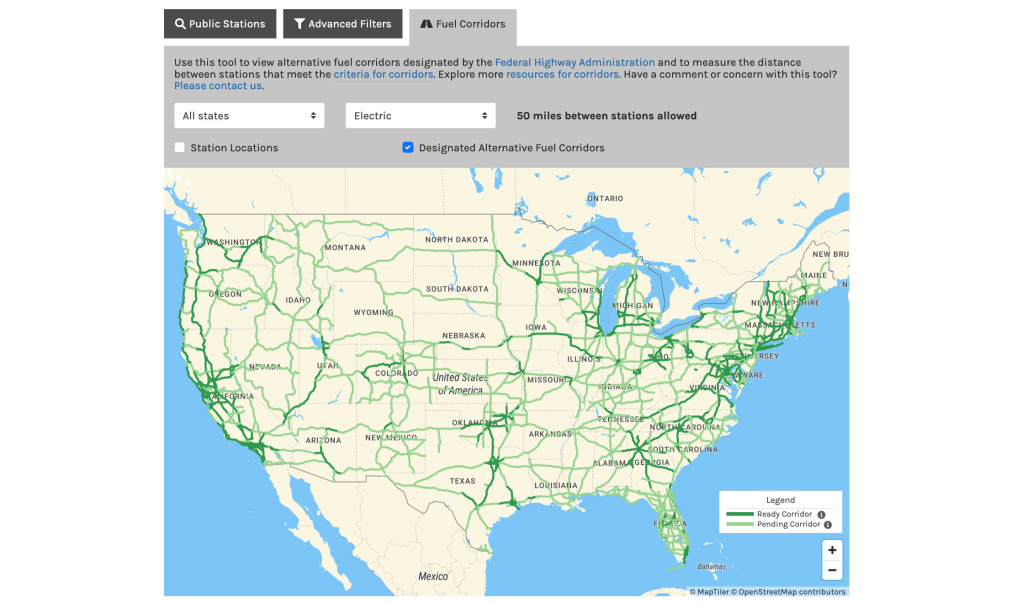This Thanksgiving weekend, as families take to the highways to visit friends or family, EVs are more likely than ever to be part of the dinner conversation.
Product is a big part of it. With the introduction of electric trucks such as the F-150 Lightning, off-road-capable SUVs such as the Rivian R1S, and affordable options such as the Chevrolet Bolt EV, vehicle choice is less likely to stand in the way of EV adoption.
But the dearth of chargers on the annual holiday trip may be what puts off big vehicle decisions, and keeps the gasoline family vehicle around for another year. If you still might be cutting it too close on electric-vehicle range now, will the growing charging infrastructure allow it next year?
While existing options including Tesla’s Supercharger network and Electrify America may hint about chargers due to open in a few months, they don’t let us see into the future to see if holiday drive routes will be different next year. Both networks tend to cover the major highway and cross-country routes but leave vast portions of the nation disconnected with respect to road-trip fast-charging.
![Tesla electric cars at Supercharger fast-charging site, TK [photo: Jay Lucas] Tesla electric cars at Supercharger fast-charging site, TK [photo: Jay Lucas]](https://images.hgmsites.net/lrg/tesla-electric-cars-at-supercharger-fast-charging-site-tk-photo-jay-lucas_100648832_l.jpg)
Tesla electric cars at Supercharger fast-charging site, TK [photo: Jay Lucas]
For a more decisive answer on whether those highway charging gaps might be filled next year—or in a couple of years—we do have one good source: the federal government.
A great start for a federal charging network
The Bipartisan Infrastructure Law enacted in November 2021 approved $7.5 billion for EV charging. That was split into two pieces: $5 billion for the National Electric Vehicle Infrastructure (NEVI) program, and $2.5 billion for a discretionary grant program to tackle rural charging and underserved and/or disadvantaged communities.
There are two core facets of the $5 billion NEVI program: the deployment of approved state-proposed EV charging infrastructure, plus the formation of “an interconnected network to facilitate data collection, access, and reliability.” For the former, it’s split over five years, and it arrives in a first tranche of $615 million for the fiscal year 2022 and an estimated $885 million for fiscal year 2023.
The program required that individual state plans be submitted to the federal government, laying out plans for the federal EV charging network set to place at least four 150-kw DC fast-charging connectors every 50 miles.
While NEVI plans submitted by states varied widely, all states essentially did their homework on time and got their plans in by August 1. By mid-September, plans from an initial batch of 35 states were approved for funding and charger installation, and all the states were greenlit by the end of the month.
All laid out in plans—and on a map
The program required that ahead of any plan approval, charging routes be designated Alternative Fuel Corridors. In the weeks and months up to the proposals, states went through a separate process with the federal government to fine-tune that designation.
You can browse each of the state plans for EV charging via the Joint Office of Energy and Transportation. But if you don’t have time to scroll through reports, there’s a resource you can consult at quick glance to check that holiday route (or summer vacation route): Go to the Energy Department’s Alternative Fueling Station Locator, make sure you’ve checked just the “Designated Alternative Fuel Corridors,” and then zoom in on your designated route.

Alternative Fuels Corridors for EVs - DOE Alternative Fuels Data Center, Nov. 2022
The routes drawn in dark green are designated Alternative Fuel Corridors, and it’s highly likely they’re either built out with chargers already or will be soon. The routes that are light green indicate pending corridors, and they’ll almost certainly be built out with chargers as part of the federal network by the middle of the decade.
You’ll need to look at the respective state plan to see the particulars of when that will happen, but if you don’t see your route, then any charger coverage will depend on whether those other charging networks see a business model.
Even after the buildout there will be some significant gaps. But if you currently have to drive in a fast-charging desert, even once or twice a year, the federal EV charging map can be a glance into the future—and whether you too can more comfortably make the leap to an EV.













